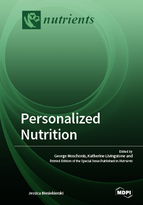Personalized Nutrition-1
A special issue of Nutrients (ISSN 2072-6643).
Deadline for manuscript submissions: closed (31 March 2019) | Viewed by 80491
Special Issue Editors
Interests: nutritional epidemiology; nutritional assessment; nutritional counselling; functional foods
Special Issues, Collections and Topics in MDPI journals
Interests: dietary patterns; diet quality; obesity; cardiovascular disease; personalised nutrition
Special Issues, Collections and Topics in MDPI journals
Interests: gastrointestinal health; food intolerances; gut-brain axis; meal ingestion
Special Issue Information
Dear Colleagues,
“Personalised Nutrition” represents any initiative that attempts to provide tailor-made healthy eating advice based on the nutritional needs of each individual, as these are dictated by the individual’s behaviour, phenotype and/or genotype, and their interactions. This Special Issue of Nutrients is dedicated to the development, implementation and assessment of the effectiveness of evidence-based “Personalised Nutrition” strategies. In this regard, a selection of reviews and original research manuscripts will bring together the latest evidence on how lifestyle habits, physiology, nutraceuticals, gut microbiome and genetics can be integrated into nutritional solutions, specific to the needs of each individual, for maintaining health and preventing diseases.
Assoc. Prof. George Moschonis
Dr. Katherine Livingstone
Dr. Jessica Biesiekierski
Guest Editors
Manuscript Submission Information
Manuscripts should be submitted online at www.mdpi.com by registering and logging in to this website. Once you are registered, click here to go to the submission form. Manuscripts can be submitted until the deadline. All submissions that pass pre-check are peer-reviewed. Accepted papers will be published continuously in the journal (as soon as accepted) and will be listed together on the special issue website. Research articles, review articles as well as short communications are invited. For planned papers, a title and short abstract (about 100 words) can be sent to the Editorial Office for announcement on this website.
Submitted manuscripts should not have been published previously, nor be under consideration for publication elsewhere (except conference proceedings papers). All manuscripts are thoroughly refereed through a single-blind peer-review process. A guide for authors and other relevant information for submission of manuscripts is available on the Instructions for Authors page. Nutrients is an international peer-reviewed open access semimonthly journal published by MDPI.
Please visit the Instructions for Authors page before submitting a manuscript. The Article Processing Charge (APC) for publication in this open access journal is 2900 CHF (Swiss Francs). Submitted papers should be well formatted and use good English. Authors may use MDPI's English editing service prior to publication or during author revisions.
Keywords
- Personalised
- Lifestyle
- Phenotype
- Nutraceuticals
- Microbiome
- Genotype
- Nutrition








